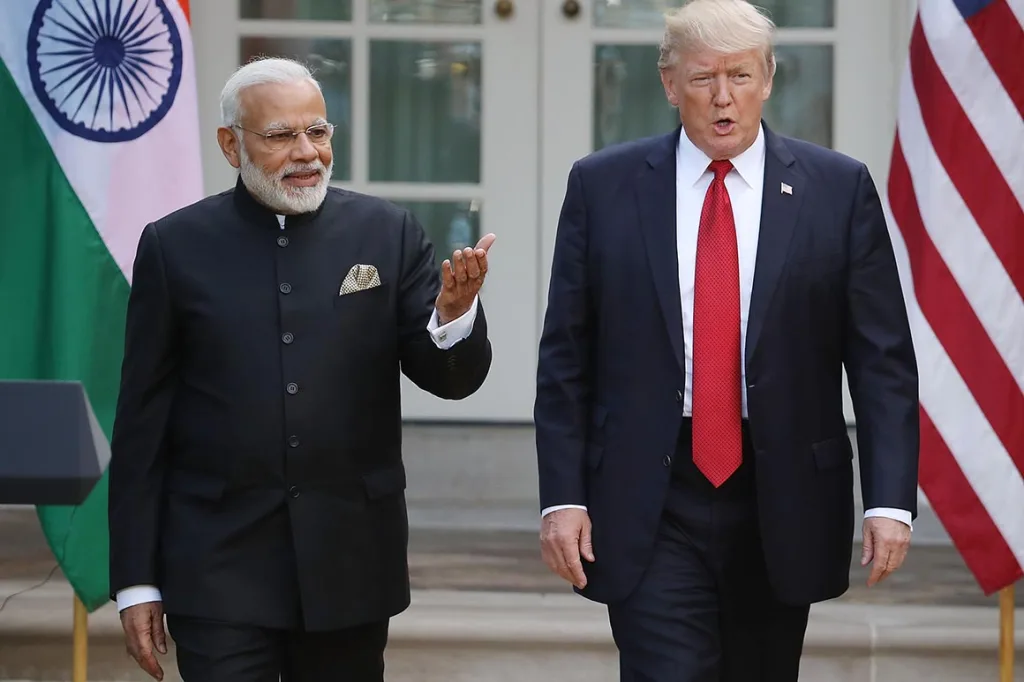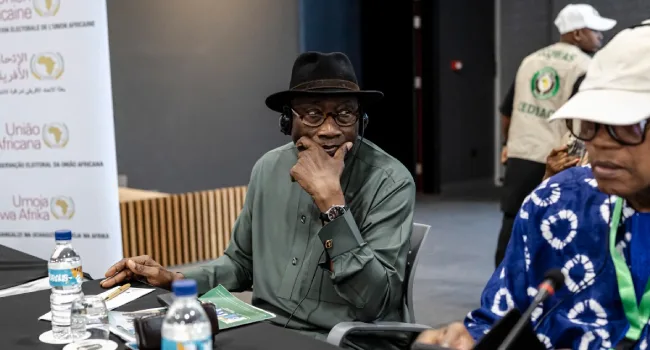
Relations between the US and India is at a significant low/Getty Images
The partnership between India and the United States has reached a notable breaking point.
As planned, U.S. President Donald Trump’s decision to double tariffs on Indian imports to as much as 50% went into effect on Wednesday, dealing a substantial blow to relations between the two nations that had developed into strategic allies following the start of the new millennium.
An additional 25% punitive tariff imposed because of India’s Russian oil purchases compounds Trump’s existing 25% tariff on numerous imports from the South Asian country.
This brings combined duties to as much as 50% for products including garments, gems and jewellery, footwear, sporting goods, furniture and chemicals – ranking among the steepest levied by the U.S. and matching those applied to Brazil and China.
Related: UK Set To Stop Issuing Visas To Nigerian Doctors
The additional tariffs pose a threat to thousands of small-scale exporters and employment opportunities, particularly in Prime Minister Narendra Modi’s home state of Gujarat, and are anticipated to damage growth in the world’s most rapidly expanding major economy.
Wednesday saw no domestic market response to the development as stock exchanges remained closed for a Hindu festival, but equity indices recorded their most severe session in three months on Tuesday following a Washington announcement that confirmed the supplementary tariff.
The Indian rupee also extended its decline for a fifth straight session on Tuesday, closing at its weakest point in three weeks.
Although the tariff disruption would be damaging, it might not spell complete disaster for the world’s fifth-largest economy if New Delhi can advance economic reforms and adopt less protectionist policies while working to resolve the crisis with Washington, according to analysts.
India’s Commerce Ministry did not provide an immediate response to a comment request on Wednesday. Nevertheless, a Commerce Ministry official, speaking under anonymity conditions, indicated that exporters affected by tariffs would receive financial support and be urged to diversify into markets including China, Latin America and the Middle East.
A U.S. Customs and Border Protection advisory to shippers provides a three-week exception for Indian merchandise that was loaded onto vessels and en route to the U.S. before the midnight cutoff.
Also excluded are steel, aluminum and derivative products, passenger vehicles, copper and other goods already subject to separate tariffs reaching 50% under the Section 232 national security trade legislation.
Indian trade ministry officials report the average tariff on U.S. imports stands at approximately 7.5%, while the U.S. Trade Representative’s office has emphasized rates reaching 100% on automobiles and an average applied tariff rate of 39% on U.S. agricultural products.
UNSUCCESSFUL NEGOTIATIONS
As the midnight implementation deadline neared, U.S. officials provided no indication that India could avoid the tariffs.
Wednesday’s tariff implementation follows five rounds of unsuccessful negotiations, during which Indian officials had expressed hope that U.S. tariffs might be limited to 15%, the rate extended to goods from certain other major U.S. trading partners including Japan, South Korea and the European Union.
Representatives from both nations attributed the negotiation collapse to political miscalculations and miscommunications. Their bilateral goods trade reached $129 billion in 2024, resulting in a $45.8 billion U.S. trade deficit, based on U.S. Census Bureau statistics.
Washington maintains that India’s purchase of Russian oil helps fund Moscow’s war in Ukraine and that New Delhi also profits from it. India has rejected the accusation as double standards, pointing at U.S. and European trade links with Russia.

 Former President Jonathan Says Coup Did Not Happen In Guinea-Bissau
Former President Jonathan Says Coup Did Not Happen In Guinea-Bissau ![On Thursday, November 27, 2025, General Horta Inta-A of Guinea-Bissau salutes an officer at his swearing-in ceremony in Bissau, where he assumed the role of transitional leader and head of the High Command [Patrick Meinhardt/AFP]](https://www.lionscrib.com/wp-content/uploads/2025/11/image-10-720x513.webp) General Horta Inta-A Sworn In As Interim Leader Of Guinea Bissau After Coup
General Horta Inta-A Sworn In As Interim Leader Of Guinea Bissau After Coup  First Openly Gay Woman Wins Miss England Crown
First Openly Gay Woman Wins Miss England Crown  Gunmen Attack Convoy Of Former Minister Chris Ngige In Anambra
Gunmen Attack Convoy Of Former Minister Chris Ngige In Anambra  Why President Tinubu Declared A State Of Emergency On Security
Why President Tinubu Declared A State Of Emergency On Security  Ukraine Reportedly Accepts Trump’s Peace Plan To End War With Russia
Ukraine Reportedly Accepts Trump’s Peace Plan To End War With Russia